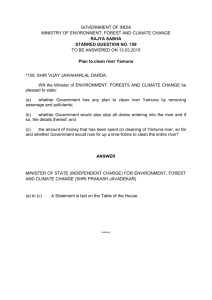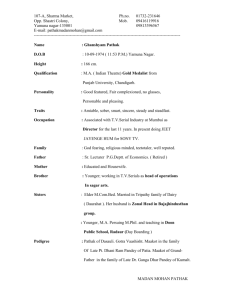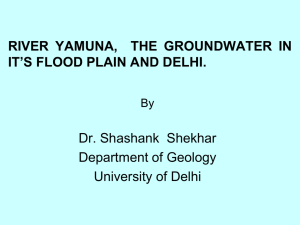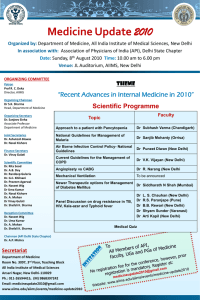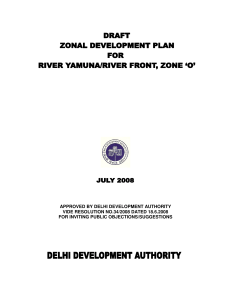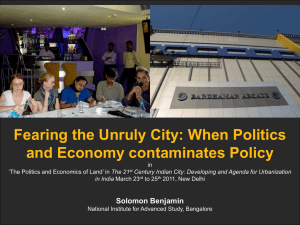Yamuna - Gangapedia
advertisement
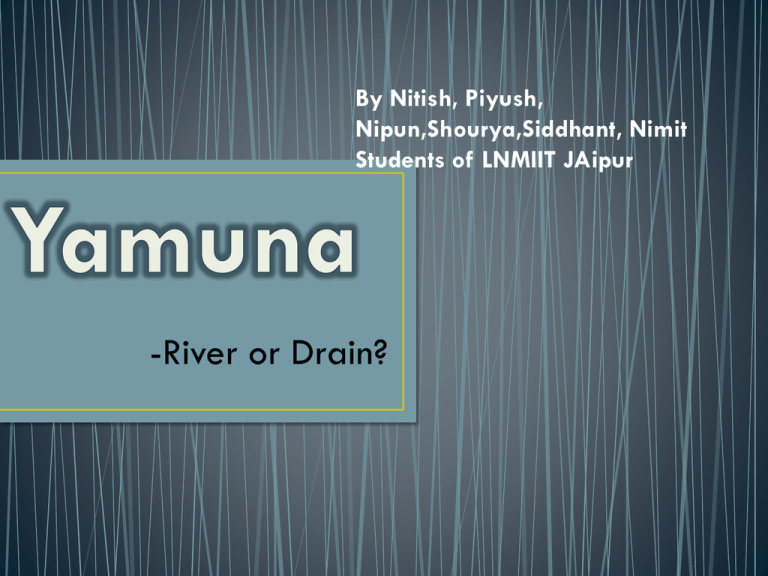
By Nitish, Piyush, Nipun,Shourya,Siddhant, Nimit Students of LNMIIT JAipur -River or Drain? • • • • Visit the Pollution Control Office of Delhi and collect data pertaining to pollution in Yamuna. Suggest ways to minimize the pollution from the major sources. Make an action plan Start an awareness campaign through a poster competition. FACTS & FIGURES Source : Yamunotri Length : 1,370 km Coverage : Uttaranchal, Uttar Pradesh, Haryana and Delhi Tributaries : Chambal, Betwa, Sind & Ken • It is said that, Yamuna is the consort of Lord Shri Krishna. • Yamuna descended down the hills and reached the plains at Khandav Vana which has been developed as Delhi city now. • Yamuna and Yama are believed to be the offspring of Sun God 'Surya'. Hence it is considered that whoever takes a dip in the holy waters of the source stream of Yamuna may not have fear of death. Yamuna in Earlier days • The main stream of the river Yamuna originated from the Yamunotri glacier near Bandar Punch in the Mussorie range of lower Himalayas in the district of Uttar Kashi in Uttar Pradesh. • Some say the source of the river is the Saptarishi Kund, a glacial lake. • The Yamuna river passing through 22 km in Delhi was once described as the lifeline of the city, but today it has become one of the dirtiest rivers in the country. • Delhi generates about 3,267 million litres per day (mld) of sewage while the city's installed waste water treatment capacity is only 2,330 mld. More than 937 mld of waste is not treated. Out of Delhi's 2,330 mld treatment capacity, 37 per cent is under-utilised and 1,270 mld of sewage is untreated and allowed to enter the river everyday. • The Yamuna’s 22-km stretch in Delhi is barely 2 per cent of the length of the river, but contributes over 70 per cent of the pollution load. • Pollution levels in the Yamuna have risen. Biochemical oxygen demand (BOD) load has increased by 2.5 times between 1980 and 2005 - from 117 tonnes per day (TPD) in 1980 to 276 TPD in 2005. • Delhi discharges about 3,684 MLD (million litres per day) of sewage into the Yamuna. • The faecal coliform count, which indicates the presence of disease causing micro- organisms, is nearly 25,000 times more than the limit prescribed for bathing. • Delhi and Agra together account for 90 per cent of the pollution in the river. • The Capital has 16 drains discharging treated and untreated wastewater/sewage into Yamuna. • The Najafgarh drain contributes to 60% of the total wastewater and 45 per cent of the total BOD load being discharged from Delhi into the Yamuna. The municipal wastewater has increased from 960 MLD in 1977 to 1,900 MLD in 1997. • The capacity for treatment -increased from 450 MLD in 1977 to 1,270 MLD in 1997. • All existing Industries, dumping the waste water in Yamuna, should setup a waste water management plant at their source, and new industries should be given license only if they have a waste management plant • Extensive plantation on banks of Yamuna • Sewerage should flow in the river only after treatment • Electric Crematoriums should be built and their usage encouraged • Community Toilets and low cost sanitation to be built and usage encouraged • Religious activities: • Idols made of POP should be banned and mud idols should be used for immersion. • Use of soap and detergents during ritual baths should be banned • Plan to mobilise people so that they follow the Action plan and be vigilant enough to deter others from violating the plan. • Sharing of awareness posters with the community • Making Eco clubs in the localities and these clubs will take up the responsibility to clean the banks regularly and mobilise support. • Union Environment Minister Jairam Ramesh recently said that Yamuna is not a river in Delhi. It is nothing better than a nullah. So, whatever happened to the Rs 1,800 crore granted by the government of Delhi that was supposed to be spent on cleaning the river? • Yamuna is dead in a city that expresses no gratitude towards the river that meets more than 70 per cent of its water demand (before it turns into a virtual drain at Wazirabad in west Delhi. • If towns (like Agra) downstream do what Delhi is so ruthlessly doing to the river, then even this 'river-nullah' might turn into a multitude of open sewers and drains. As environmentalist Sunita Narain said cryptically: "The River is dead. It just has not been officially cremated." Shocked activist Ginny Harris of the Alice Ferguson Foundation which is involved in the Potomac river cleaning in Washington DC, exclaimed: "My god, you call this a river!" while interacting with local activists. The river is filled with garbage floating on the surface. This includes everything from plants to human waste. . • River Thames in London was so polluted and stinking in the year 1850 that the British Parliament had to be shifted away from the river, says Robert Oates, director of the Thames River Restoration Trust. • A century and half on, the river is much cleaner and Britain, he says, is now investing in cleaning a tributary of the Thames, the Lee, ahead of the London Olympics in 2012. Yamuna - Today Earlier Now Yamuna was clean, serene and green People love to visit for boating & picnic People used to compose poems on the beauty of Yamuna People used to take holy dip in the sacred river Yamuna is dirty, polluted and stinky Industries are throwing industries waste Yamuna banks is used as garbage dumping ground Now animals are getting bathed, Dead bodies are cremated in Yamuna Most probable number (MPN): per 100 ml of sample1 Poster Making & Public awareness • • • • • Wikipedia www.knowyourrivers.com Locals and elders Old newspapers and magazines Pollution Control Office of Delhi • Piyush Kumar Tiwari – Y10UC217: Research and content. • Nipun Ashwini Iyer – Y10UC200: Extraction and compilation of data and Powerpoint. • Shourya Ranka – Y10UC311:Photography and Powerpoint. • Nitish Bansal – Y10UC204: Photography. • Nimit Malhotra – Y10UC199: Presentation. • Siddhant Sardana – Y10UC322: Photography and Facilitator.
